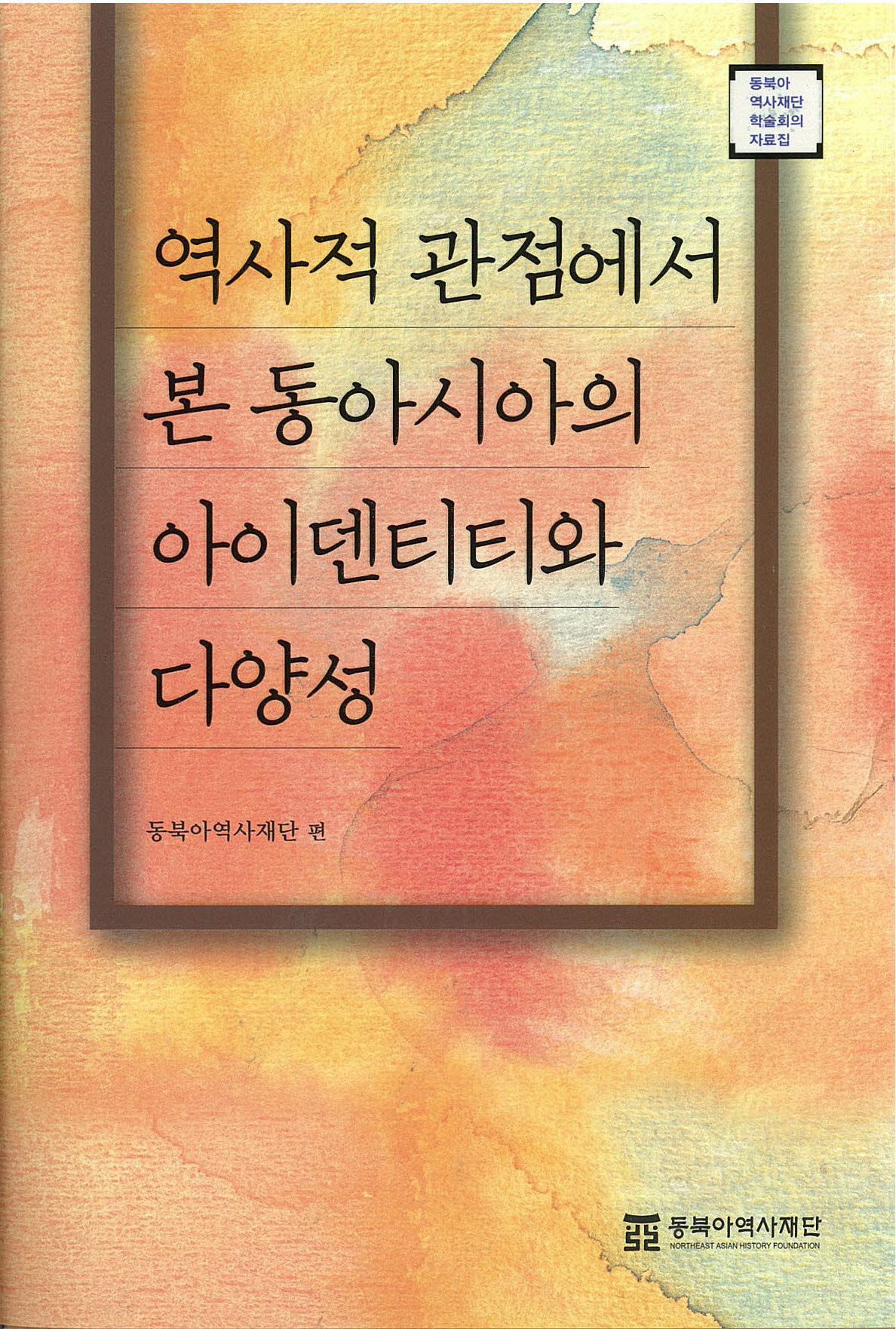Publication
- Date2011.06.20
- Hit963

1. All rights of the contents and the electronic files in the Webpage are reserved for the Northeast Asia History Foundation.
2. No part of the Webpage may be reproduced, stored in retrieval system, or transmitted, in any form or by any means, without the prior permission.
Title: Identity and Diversity of the World of East Asia from a Historical Perspective
Northeast Asian History Foundation (Ed.)
Small Octavo Edition / 370 pages / 2010 / KRW14,000 (US$12) / ISBN 978-89-6187-190-7
The title is a collection of papers presented at the international conference under the title, “Identity and Diversity of the World of East Asia from a Historical Perspective”, which took place on November 6-7, 2009. A total of 13 papers on homogeneity and diversity of East Asia, presented by scholars from Korea, China, Japan and Taiwan, are included in the title. The authors explored possibilities for East Asian Community and shared perception of history transcending national borders. In particular, they emphasized that shared perception of history is the starting point for developing a sense of community in East Asia. The title holds significance in that ways to achieve shared prosperity and the spirit of "East Asian" community are discussed from the perspective of mutual exchanges.
Table of Contents
• East Asian identity and perception of history transcending borders / Bu Ping (歩平)
1. Identity in Europe and East Asia, and "East Asian Community"
2. Efforts to establish shared perception of history regardless of national borders
3. Different perspectives of dialogue regarding historical issues
4. Perception of history : transcending borders
• Understanding history / Wu Micha (吳密察)
- the 1930 Wushe Incident : memories and interpretation -
1. Introduction
2. Wushe Incident
3. Retrospective research on Wushe Incident
4. Reviving memories of Wushe Incident
5. Conclusion
• Perception of East Asia in modern Korea : origin and development / Choi, Deok Soo
1. Introduction
2. Perception of East Asia from the perspective of "Little China (小中華)"
3. Perception of the world from the perspective of "West were Differentiation (倭洋分別論)"
4. Perception of the world from the perspective of “International Law (萬國公法)”
5. Conclusion
• Impact of different historical experiences of modern China and Japan on the sense of community in East Asia / Liang Yunxiang (梁云祥)
1. Introduction
2. Identity and perception of East Asian regional community
3. Intensification of segmentation in East Asia due to different historical experiences of China and Japan in modern and comtemporary history
4. Re-integration of East Asia before and after the end of Cold War
• Perception and description of East Asia in China / Xu Xiuli (徐秀麗)
Overview
1. Perception of East Asia in China
2. Rationality of establishing description of East Asia
• Russo-Japanese War and national history / Nakamura Masanori (中村政則)
1. Introduction
2. What is
3. Meiji Restoration & Freedom and People's Right Movement (自由民權運動)
4. First Sino-Japanese War
5. Russo-Japanese War
6. War diplomacy (개전외교)
7. Media structure
8. Images of each other
9. Conclusion
• Memories of Korean War : cold war or post-cold war / Jung, Keun Sik
- Photographs of war and memorial -
1. Memories of war on the 60th anniversary
2. Photographs of war and politics of memory
3. Photograph collection and change of perspective
1) Korean War from "our perspective"
2) Korean War from "their perspective"
3) Attempts to overcome dichotomy
4. Use of photographs in war memorials
5. Reflecting on memories of war
• Gandhi in Taiwan / Chen Weizhi (陳偉智)
- critical review of discussions regarding “overcoming division (분단체제초극)” of
1. Introduction
2. Peace Police Law violation trial in Taiwan (1924)
3. Time and space of the theory of small nations (弱小民族論)
4. Possibility of transition from national liberation to social reform
5. Conclusion
• East Asian perspective on the identity of Taiwan / Baik, Ji Woon
1. Approach toward China - Taiwan issues
2. Summon of East Asia : overcoming "orphan consciousness"
3. Who are the stakeholders in overcoming division and China - Taiwan system
1) Nation, post-nation and "Chinese"
2) Overcoming the dilemma of China - Taiwan issues
4. Overcoming China - Taiwan division and East Asia
5. Conclusion
• Expatriates' settlement in Hakodate in the 19th century and Chinese merchants / Ogawa Masaki (小川正樹)
- from Hakodate to Hokkaido -
1. Introduction
2. Overseas Chinese in Hakodate
3. Overseas Chinese in Hokkaido
4. Conclusion
• Historical experience of people crossing borders (1945~1948) / Gobayashi Somei (小林聰明)
- Dynamics of movements between Japan and South Korea under U.S. forces -
1. Introduction
2. Returning home
1) Ethnic Koreans in Japan heading for hometown
2) Support from South Korea for returnees
3) Aggravated South Korean economy and returnees suffering financial distress
3. Smuggling as a means of survival
1) Illegal movement under surveillance
2) Return of Japanese from Korea and transfer of properties
3) Ethnic Koreans returning to Japan
4. Repatriation ― Expulsion from Japanese society
1) Development of repatriation promotion policies
2) Implementation of repatriation
3) Ethnic Koreans in Japan resisting repatriation
5. Conclusion
• Perception of the other of Chinese merchants in Joseon in transition period to modern history :
documents regarding overseas Chinese merchant, Tongsuntae / Kang, Jin A
1. Introduction
2. Advancement of overseas Chinese in late Korean Empire and Tongsuntae
3. Borderline between regionalism and nationalism (동향의식과 국민의식의 경계)
4. Between politics and embarrassing part
5. Dualistic perspectives on Sino-Japanese War
6. Conclusion
• Incorporating "Manchuria" into China / Ueda Takako (上田貴子)
- Formation of identity in the Fengtian region during the late 19th century and early 20th century -
1. Introduction
2. Local community in Fengtian
3. Changes in chamber of commerce (商會) and local community in Fengtian (chaotic period : 1905~1911)
4. Changes in chamber of commerce (商會) and local community in Fengtian (stable period : 1911~1924)
5. Changes in chamber of commerce (商會) and local community in Fengtian (transitional period : 1924~1931)
6. Conclusion
